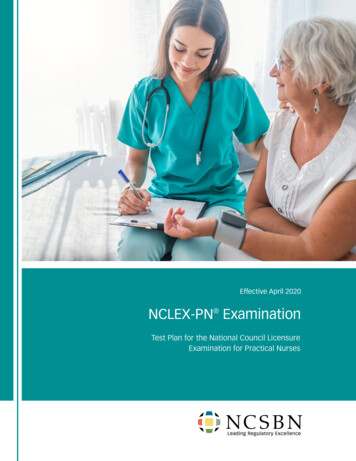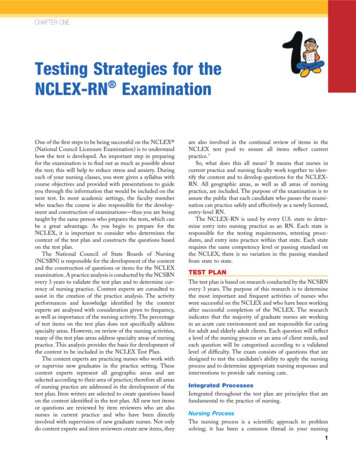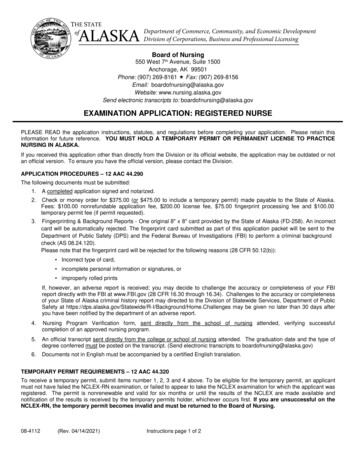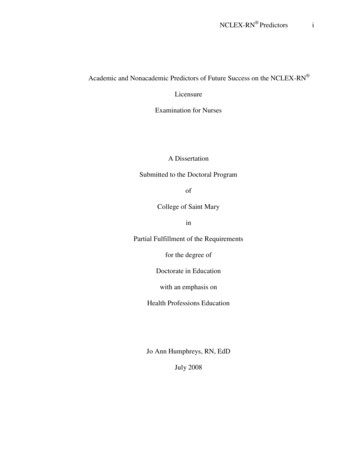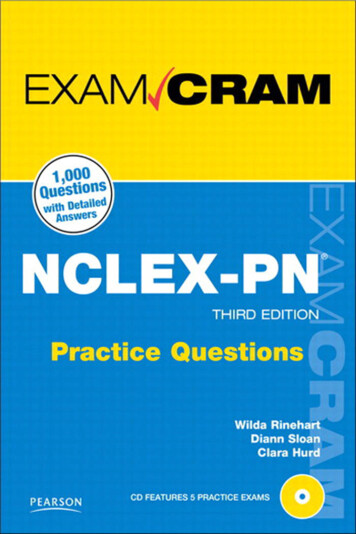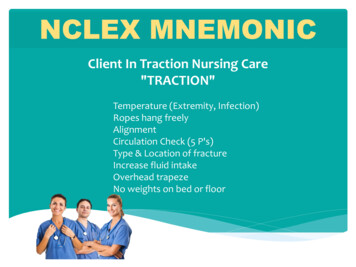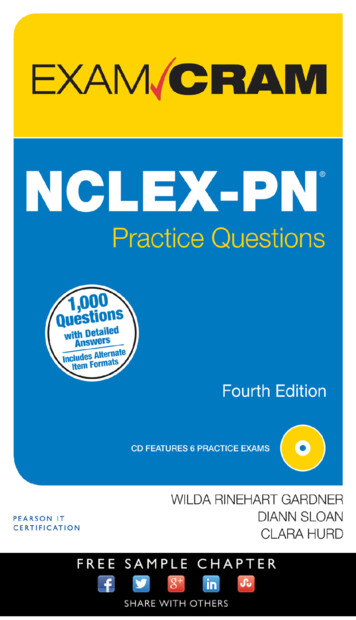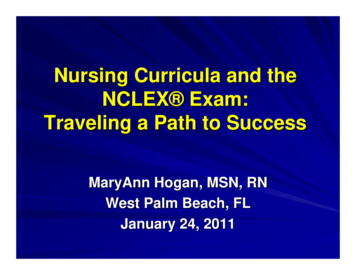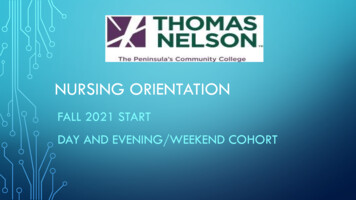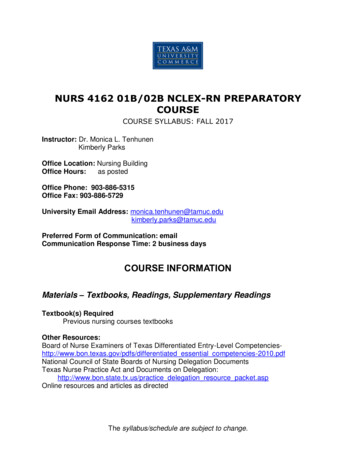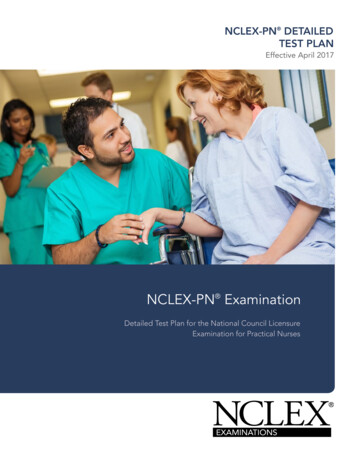
Transcription
NCLEX-PN DETAILEDTEST PLANEffective April 2017NCLEX-PN ExaminationDetailed Test Plan for the National Council LicensureExamination for Practical Nurses
Mission StatementThe National Council of State Boards of Nursing (NCSBN ) provides education, service and research through collaborative leadership to promote evidence-based regulatory excellence for patient safety and public protection.Copyright 2016 National Council of State Boards of Nursing, Inc. (NCSBN )All rights reserved. NCSBN , NCLEX , NCLEX-RN , NCLEX-PN , NNAAP , MACE , Nursys and TERCAP are registeredtrademarks of NCSBN and this document may not be used, reproduced or disseminated to any third party without writtenpermission from NCSBN.Permission is granted to boards of nursing to use or reproduce all or parts of this document for licensure related purposesonly. Nonprofit education programs have permission to use or reproduce all or parts of this document for educational purposes only. Use or reproduction of this document for commercial or for-profit use is strictly prohibited. Any authorizedreproduction of this document shall display the notice: “Copyright by the National Council of State Boards of Nursing, Inc.All rights reserved.” Or, if a portion of the document is reproduced or incorporated in other materials, such written materialsshall include the following credit: “Portions copyrighted by the National Council of State Boards of Nursing, Inc. All rightsreserved.”Address inquiries in writing to NCSBN Permissions, 111 E. Wacker Drive, Suite 2900, Chicago, IL 60601-4277. SuggestedCitation: National Council of State Boards of Nursing.
i2017 NCLEX-PN Detailed Test PlanItem Writer/Item Reviewer/Nurse Educator VersionNational Council of StateBoards of Nursing2017 NCLEX-PN Detailed Test PlanItem Writer/Item Reviewer/Nurse Educator VersionEffective DateApril 2017
iii2017 NCLEX-PN Detailed Test PlanItem Writer/Item Reviewer/Nurse Educator VersionTable of ContentsI. Background. . . . . . . . . . . . . . . . . . . . . . . . . . . . . . . . . . . . . . . . . . . . . . . . . . . . . . . . . . . . . . . . . . . . . . . . . . . 1II. 2017 NCLEX-PN Test Plan . . . . . . . . . . . . . . . . . . . . . . . . . . . . . . . . . . . . . . . . . . . . . . . . . . . . . . . . . . . . . . 3Introduction. . . . . . . . . . . . . . . . . . . . . . . . . . . . . . . . . . . . . . . . . . . . . . . . . . . . . . . . . . . . . . . . . . . . . . . . . 3Beliefs . . . . . . . . . . . . . . . . . . . . . . . . . . . . . . . . . . . . . . . . . . . . . . . . . . . . . . . . . . . . . . . . . . . . . . . . . . . . . 3Classification of Cognitive Levels. . . . . . . . . . . . . . . . . . . . . . . . . . . . . . . . . . . . . . . . . . . . . . . . . . . . . . . 4Test Plan Structure . . . . . . . . . . . . . . . . . . . . . . . . . . . . . . . . . . . . . . . . . . . . . . . . . . . . . . . . . . . . . . . . . . . 4 Client Needs. . . . . . . . . . . . . . . . . . . . . . . . . . . . . . . . . . . . . . . . . . . . . . . . . . . . . . . . . . . . . . . . . . 4 Integrated Processes . . . . . . . . . . . . . . . . . . . . . . . . . . . . . . . . . . . . . . . . . . . . . . . . . . . . . . . . . . . 5Distribution of Content . . . . . . . . . . . . . . . . . . . . . . . . . . . . . . . . . . . . . . . . . . . . . . . . . . . . . . . . . . . . . . . 5Overview of Content . . . . . . . . . . . . . . . . . . . . . . . . . . . . . . . . . . . . . . . . . . . . . . . . . . . . . . . . . . . . . . . . . 6III. 2017 NCLEX-PN Detailed Test Plan. . . . . . . . . . . . . . . . . . . . . . . . . . . . . . . . . . . . . . . . . . . . . . . . . . . . . . 9Safe and Effective Care Environment . . . . . . . . . . . . . . . . . . . . . . . . . . . . . . . . . . . . . . . . . . . . . . . . . . 10 Coordinated Care. . . . . . . . . . . . . . . . . . . . . . . . . . . . . . . . . . . . . . . . . . . . . . . . . . . . . . . . . . . . . 10 Safety and Infection Control . . . . . . . . . . . . . . . . . . . . . . . . . . . . . . . . . . . . . . . . . . . . . . . . . . . . 15Health Promotion and Maintenance. . . . . . . . . . . . . . . . . . . . . . . . . . . . . . . . . . . . . . . . . . . . . . . . . . . . 18Psychosocial Integrity. . . . . . . . . . . . . . . . . . . . . . . . . . . . . . . . . . . . . . . . . . . . . . . . . . . . . . . . . . . . . . . . 22Physiological Integrity . . . . . . . . . . . . . . . . . . . . . . . . . . . . . . . . . . . . . . . . . . . . . . . . . . . . . . . . . . . . . . . 27 Basic Care and Comfort. . . . . . . . . . . . . . . . . . . . . . . . . . . . . . . . . . . . . . . . . . . . . . . . . . . . . . . . 27 Pharmacological Therapies . . . . . . . . . . . . . . . . . . . . . . . . . . . . . . . . . . . . . . . . . . . . . . . . . . . . . 30 Reduction of Risk Potential . . . . . . . . . . . . . . . . . . . . . . . . . . . . . . . . . . . . . . . . . . . . . . . . . . . . . 33 Physiological Adaptation. . . . . . . . . . . . . . . . . . . . . . . . . . . . . . . . . . . . . . . . . . . . . . . . . . . . . . . 36IV. Administration of the NCLEX-PN Examination . . . . . . . . . . . . . . . . . . . . . . . . . . . . . . . . . . . . . . . . . . . 39Examination Length. . . . . . . . . . . . . . . . . . . . . . . . . . . . . . . . . . . . . . . . . . . . . . . . . . . . . . . . . . . . . . . . . 39The Passing Standard. . . . . . . . . . . . . . . . . . . . . . . . . . . . . . . . . . . . . . . . . . . . . . . . . . . . . . . . . . . . . . . . 39Similar Items. . . . . . . . . . . . . . . . . . . . . . . . . . . . . . . . . . . . . . . . . . . . . . . . . . . . . . . . . . . . . . . . . . . . . . . 40Reviewing Answers and Guessing. . . . . . . . . . . . . . . . . . . . . . . . . . . . . . . . . . . . . . . . . . . . . . . . . . . . . . 40Scoring the NCLEX Examination. . . . . . . . . . . . . . . . . . . . . . . . . . . . . . . . . . . . . . . . . . . . . . . . . . . . . . 40 Computerized Adaptive Testing (CAT). . . . . . . . . . . . . . . . . . . . . . . . . . . . . . . . . . . . . . . . . . . . 40 Pretest Items. . . . . . . . . . . . . . . . . . . . . . . . . . . . . . . . . . . . . . . . . . . . . . . . . . . . . . . . . . . . . . . . . 41 Passing and Failing. . . . . . . . . . . . . . . . . . . . . . . . . . . . . . . . . . . . . . . . . . . . . . . . . . . . . . . . . . . . 41 Scoring Items. . . . . . . . . . . . . . . . . . . . . . . . . . . . . . . . . . . . . . . . . . . . . . . . . . . . . . . . . . . . . . . . . 42 Types of Items on the NCLEX-PN Examination . . . . . . . . . . . . . . . . . . . . . . . . . . . . . . . . . . . . 42 NCLEX Examination Terminology . . . . . . . . . . . . . . . . . . . . . . . . . . . . . . . . . . . . . . . . . . . . . . . 42 Confidentiality . . . . . . . . . . . . . . . . . . . . . . . . . . . . . . . . . . . . . . . . . . . . . . . . . . . . . . . . . . . . . . . 42 Tutorial. . . . . . . . . . . . . . . . . . . . . . . . . . . . . . . . . . . . . . . . . . . . . . . . . . . . . . . . . . . . . . . . . . . . . . 42V. Item Writing Exercises. . . . . . . . . . . . . . . . . . . . . . . . . . . . . . . . . . . . . . . . . . . . . . . . . . . . . . . . . . . . . . . . . 51VI. References . . . . . . . . . . . . . . . . . . . . . . . . . . . . . . . . . . . . . . . . . . . . . . . . . . . . . . . . . . . . . . . . . . . . . . . . . 54Appendix A . . . . . . . . . . . . . . . . . . . . . . . . . . . . . . . . . . . . . . . . . . . . . . . . . . . . . . . . . . . . . . . . . . . . . . . . . . . 55
12017 NCLEX-PN Detailed Test PlanItem Writer/Item Reviewer/Nurse Educator VersionI. BackgroundThe Detailed Test Plan for the National Council Licensure Examination for Practical/Vocational Nurses(NCLEX-PN ) was developed by the National Council of State Boards of Nursing, Inc. (NCSBN ). The purpose ofthis document is to provide more detailed information about the content areas tested in the NCLEX-PN than isprovided in the basic NCLEX-PN Test Plan.This booklet contains: The 2017 NCLEX-PN Test Plan; Information on testing requirements and sample examination questions (items); Item writing exercises; References; and Appendix.About the NCLEX-PN Test Plan (Section II)The test plan is reviewed and approved by the NCLEX Examination Committee (NEC) every three years.Multiple resources are used, including the recent practice analysis of licensed practical/vocational nurses(LPN/VN), and expert opinions of the NEC, NCSBN content staff and boards of nursing (NCSBN’s MemberBoards) to ensure that the test plan is consistent with state nurse practice acts. Following the endorsement ofproposed revisions by the NEC, the test plan document is presented for approval to the Delegate Assembly,which is the decision-making body of NCSBN.About the NCLEX-PN Detailed Test Plan (Section III)The detailed test plan serves a variety of purposes. It is used to guide candidates preparing for the examination,to direct item writers in the development of items, and to facilitate the classification of examination items. Thisdocument offers a more thorough and comprehensive listing of content for each Client Needs category andsubcategory outlined in the test plan. Sample items are provided at the end of each category, which are specificto the Client Needs category being reviewed in that section. There is an item writing guide along with samplecase scenarios, which provide nurse educators with hands-on experience in writing NCLEX style test questions.The Candidate Version of the detailed test plan provides the same comprehensive listing of content and sampleitems for each Client Needs category and subcategory outlined in the test plan; however, it does not offer anitem writing guide or section with case scenarios.For up-to-date information on the NCLEX-PN , visit the NCSBN website at www.ncsbn.org.
22017 NCLEX-PN Detailed Test PlanItem Writer/Item Reviewer/Nurse Educator Version
32017 NCLEX-PN Detailed Test PlanItem Writer/Item Reviewer/Nurse Educator VersionII. 2017 NCLEX-PN Test PlanIntroductionEntry into the practice of nursing is regulated by the licensing authorities within each of the NCSBN MemberBoard jurisdictions (state, commonwealth and territorial boards of nursing). To ensure public protection, eachjurisdiction requires candidates for licensure to meet set requirements that include passing an examinationthat measures the competencies needed to perform safely and effectively as a newly licensed, entry-levelpractical/vocational nurse (LPN/VN). NCSBN develops a licensure examination, the National Council LicensureExamination for Practical/Vocational Nurses (NCLEX-PN ), which is used by member board jurisdictions to assistin making licensure decisions.Several steps occur in the development of the NCLEX-PN Test Plan. The first step is conducting a practice analysis that is used to collect data on the current practice of entry-level LPN/VNs (Report of Findings from the 2015LPN/VN Practice Analysis: Linking the NCLEX-PN Examination to Practice, NCSBN, 2016). Twenty-four thousandnewly licensed practical/vocational nurses are asked about the frequency and priority of performing nursingcare activities. Nursing care activities are then analyzed in relation to the frequency of performance, impact onmaintaining client safety and client care settings where the activities are performed. This analysis guides thedevelopment of a framework for entry-level nursing practice that incorporates specific client needs, as well asprocesses that are fundamental to the practice of nursing. The next step is the development of the NCLEX-PNTest Plan, which guides the selection of content and behaviors to be tested. Variations in jurisdiction laws andregulations are considered in the development of the test plan.The NCLEX-PN Test Plan provides a concise summary of the content and scope of the licensure examination.It serves as a guide for examination development as well as candidate preparation. The NCLEX examinationassesses the knowledge, skills and abilities that are essential for the entry-level LPN/VN to use in order to meetthe needs of clients requiring the promotion, maintenance or restoration of health. The following sectionsdescribe beliefs about people and nursing that are integral to the examination, cognitive abilities that will betested in the examination, and specific components of the NCLEX-PN Test Plan.BeliefsBeliefs about people and nursing underlie the NCLEX-PN Test Plan. People are finite beings with varying capacities to function in society. They are unique individuals who have defined systems of daily living reflecting theirvalues, cultures, motives and lifestyles. People have the right to make decisions regarding their health careneeds and to participate in meeting those needs. The profession of nursing makes a unique contribution inhelping clients (individuals, family or group, including significant others and population) achieve an optimal levelof health in a variety of settings. For the purposes of the NCLEX, a client is defined as the individual, family orgroup, which includes significant others and population.Nursing is both an art and a science, founded on a professional body of knowledge that integrates conceptsfrom the liberal arts, and the biological, physical, psychological and social sciences. It is a learned professionbased on an understanding of the human condition across the life span and the relationships of an individualwith others and within the environment. Nursing is a dynamic, continually evolving discipline that employscritical thinking to integrate increasingly complex knowledge, skills, technologies, and client care activities intoevidence-based nursing practice. The goal of nursing for client care is preventing illness; promoting comfort;protecting, promoting, and restoring health; and promoting dignity in dying.
42017 NCLEX-PN Detailed Test PlanItem Writer/Item Reviewer/Nurse Educator VersionThe LPN/VN uses “specialized knowledge and skills which meet the health needs of people in a variety ofsettings under the direction of qualified health professionals” (NFLPN, 2003). Considering unique cultural andspiritual client preferences, the applicable standard of care and legal instructions, the LPN/VN uses a clinicalproblem-solving process (the nursing process) to collect and organize relevant health care data, assist in theidentification of the health needs/problems throughout the client’s life span and contribute to the interdisciplinary team in a variety of settings. The entry-level LPN/VN demonstrates the essential competencies neededto care for clients with commonly occurring health problems that have predictable outcomes. “Professionalbehaviors, within the scope of nursing practice for a practical/vocational nurse, are characterized by adherenceto standards of care, accountability of one’s own actions and behaviors, and use of legal and ethical principlesin nursing practice” (NAPNES, 2007).Classification of Cognitive LevelsBloom’s taxonomy for the cognitive domain is used as a basis for writing and coding items for the examination(Bloom et al., 1956; Anderson & Krathwohl, 2001). The practice of practical/vocational nursing requires application of knowledge, skills and abilities; therefore, the majority of items are written at the application or higherlevels of cognitive ability.Test Plan StructureThe framework of Client Needs was selected because it provides a universal structure for defining nursingactions and competencies for a variety of clients across all settings and is congruent with state laws/rules.Client NeedsThe content of the NCLEX-PN Test Plan is organized into four major Client Needs categories. Two of the fourcategories are divided into subcategories:Safe and Effective Care Environment Coordinated Care Safety and Infection ControlHealth Promotion and MaintenancePsychosocial IntegrityPhysiological Integrity Basic Care and Comfort Pharmacological Therapies Reduction of Risk Potential Physiological Adaptation
52017 NCLEX-PN Detailed Test PlanItem Writer/Item Reviewer/Nurse Educator VersionIntegrated ProcessesThe following processes are fundamental to the practice of practical/vocational nursing and are integratedthroughout the Client Needs categories and subcategories: Clinical Problem-Solving Process (Nursing Process) – a scientific approach to client care that includesdata collection, planning, implementation and evaluation.Caring – interaction of the LPN/VN and client in an atmosphere of mutual respect and trust. In thiscollaborative environment, the LPN/VN provides support and compassion to help achieve desiredtherapeutic outcomes.Communication and Documentation – verbal and nonverbal interactions between the LPN/VN andthe client, as well as other members of the health care team. Events and activities associated withclient care are validated in written and/or electronic records that reflect standards of practice andaccountability in the provision of care.Teaching and Learning – facilitation of the acquisition of knowledge, skills and attitudes to assist inpromoting a change in behavior.Culture and Spirituality – interaction of the nurse and the client (individual, family or group, includingsignificant others and population) which recognizes and considers the client-reported, self-identified,unique and individual preferences to client care, the applicable standard of care and legal instructions.Distribution of ContentThe percentage of test items assigned to each Client Needs category and subcategory in the NCLEX-PN TestPlan is based on the results of the Report of Findings from the 2015 LPN/VN Practice Analysis: Linking theNCLEX-PN Examination to Practice (NCSBN, 2016) and expert judgment provided by members of the NCLEX Examination Committee.Client NeedsPercentage of Items from EachCategory/SubcategorySafe and Effective Care Environment Coordinated Care18–24% Safety and Infection Control10–16%Health Promotion and Maintenance6–12%Psychosocial Integrity9–15%Physiological Integrity Basic Care and Comfort7–13% Pharmacological Therapies10–16% Reduction of Risk Potential9–15% Physiological Adaptation7–13%
62017 NCLEX-PN Detailed Test PlanItem Writer/Item Reviewer/Nurse Educator VersionDistribution of Content for the NCLEX-PN Test PlanPhysiological Adaptation10%Coordinated Care21%Reduction of Risk Potential12%Safety and Infection Control13%Pharmacological Therapies13%Health Promotion andMaintenance9%Basic Care and Comfort10%Psychosocial Integrity12%The NCLEX-PN is administered adaptively in variable length format to target candidate-specific ability. Toaccommodate possible variations in test length, content area distributions of individual examinations may differup to 3% in each category.Overview of ContentAll content categories and subcategories reflect client needs across the life span in a variety of settings.Safe and Effective Care EnvironmentThe LPN/VN provides nursing care that contributes to the enhancement of the health care delivery setting andprotects clients and health care personnel. Coordinated Care – The LPN/VN collaborates with health care team members to facilitate effectiveclient care.Related content includes, but is not limited to: Advance Directives Establishing Priorities Advocacy Ethical Practice Client Care Assignments Informed Consent Client Rights Information Technology Collaboration with Interdisciplinary Team Legal Responsibilities Concepts of Management and Supervision Performance Improvement (Quality Improvement) Confidentiality/Information Security Referral Process Continuity of Care Resource Management
72017 NCLEX-PN Detailed Test PlanItem Writer/Item Reviewer/Nurse Educator Version Safety and Infection Control – The LPN/VN contributes to the protection of clients and health carepersonnel from health and environmental hazards.Related content includes, but
LPN/VN Practice Analysis: Linking the NCLEX-PN Examination to Practice, NCSBN, 2016). Twenty-four thousand newly licensed practical/vocational nurses are asked about the frequency and priority of performing nursing care activities. Nursing care activities are then analyz

